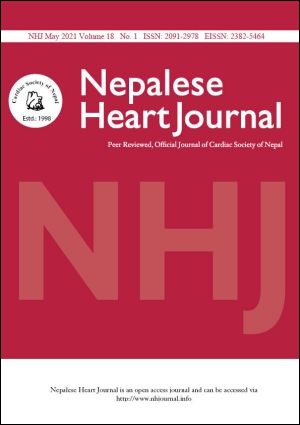The Spectrum of Congenital Heart Diseases Operated at Shahid Gangalal National Heart Center in the last 5 Years.
DOI:
https://doi.org/10.3126/njh.v18i1.36770Keywords:
Atrial Septal Defect, Cyanotic and Acyanotic Congenital Heart Disease, Tetralogy of Fallot, Ventricular Septal DefectAbstract
Background and Aims: The spectrum of congenital heart diseases (CHD) presenting for surgery to any cardiac center varies depending upon the geographical location of the center. This study is aimed to reveal the spectrum of CHD operated at a tertiary level cardiac center of Nepal.
Methods: This is a retrospective study conducted at the Department of Cardiovascular Surgery at Shahid Gangalal National Heart Center (SGNHC), Kathmandu, over a period of five years, from April 14, 2015 to April 13, 2020. All patients with a confirmed diagnosis of congenital heart disease who had undergone palliative or definitive cardiac surgery were included.
Results: Out of the total 2698 patients, there were 1374 (50.93%) females. The total number of acyanotic congenital heart disease was 1919 (71.13%), and that of cyanotic was 779 (28.87%). Male to female ratio among acyanotic and cyanotic were 0.85:1 and 1.31:1 respectively. Among all CHDs, atrial septal defect (ASD) (38.13%) followed by ventricular septal defect (VSD) (21.68%) and atrioventricular septal defect (AVSD) (5.04%) respectively were the commonest acyanotic heart lesions. Considering only the pediatric population (age 0-18 years), the commonest was VSD (27.06%) followed by ASD (22.3%) respectively. The commonest cyanotic was tetralogy of Fallot (TOF) (14.15%) followed by double outlet right ventricle (DORV) (4.44%) and total anomalous pulmonary venous connection (TAPVC) (2.89%) respectively.
Conclusion: Female population was slightly more in number amid acyanotic lesion whereas male population was dominant in cyanotic lesion. The commonest acyanotic CHD was ASD and, TOF was the commonest cyanotic lesion.
Downloads
Downloads
Published
How to Cite
Issue
Section
License
This license enables reusers to distribute, remix, adapt, and build upon the material in any medium or format, so long as attribution is given to the creator. The license allows for commercial use.




